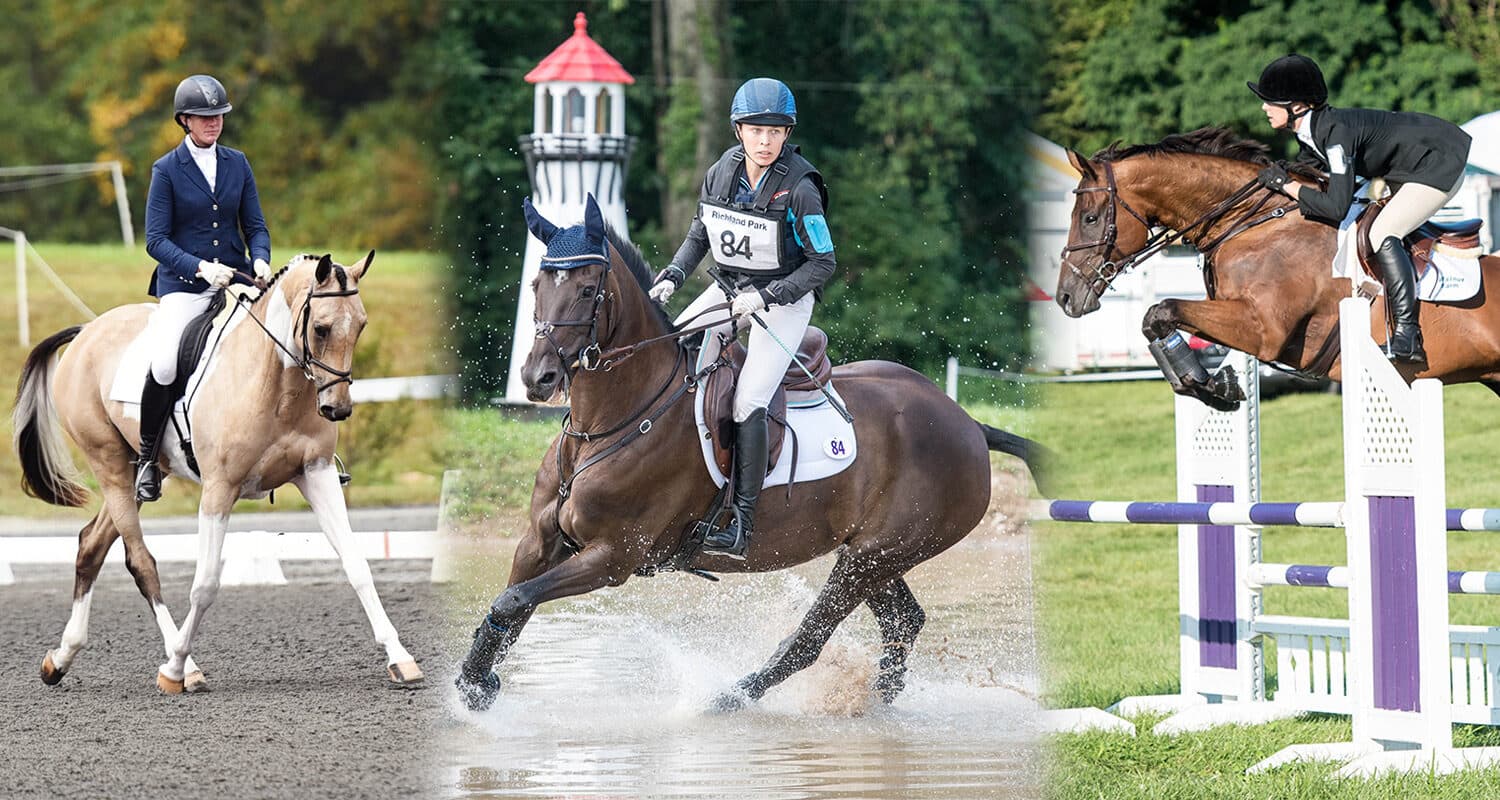Rule Refresher: Introduction to Horse Trials

Dressage, cross-country, and show jumping – the three phases that make up the sport of eventing. Whether you’re new to eventing or have been a competitor in the sport for many years, it is important to be familiar with the purpose and intent of each of the three phases and the rules by which a winner is selected.
To make sure you had a chance to review, we are taking a look at EV 131 and 132 of Subchapter 3 – Rules for Horse Trials. Text has been taken directly from the USEF Rules for Eventing with emphasis added by the USEA.
EV131 Introduction
1. DEFINITION.
The Horse Trial comprises three distinct tests, usually taking place on one or two days, during which a competitor rides the same horse throughout, namely:
a. Dressage
b. Cross-Country
c. Show Jumping
d. The Dressage Test must be first. The Cross-Country and Jumping Tests may follow in either order.
2. RELATIVE INFLUENCE OF THE TESTS.
In principle, the Cross-Country Test should be the most influential of the three tests of a Horse Trial. The Dressage Test, while less influential than the Cross-Country Test, should be slightly more influential than the Jumping Test.
3. LEVELS OF HORSE TRIALS.
The following levels of competition may be offered at a Horse Trial:
a. Advanced
b. Intermediate
c. Preliminary
d. Modified
e. Training
f. Novice
g. Beginner Novice
4. INDIVIDUAL COMPETITION.
There will always be an individual competition. Where there is a team competition, each member of a team will automatically be considered as an individual competitor.
5. TEAM COMPETITION.
There may be a team competition. Teams will consist of three or four competitors.
EV132 Classification
1. CLASSIFICATION IN THE THREE TESTS.
a. In the Dressage Test, each Competitor’s good marks awarded by the judges are converted into penalty points. They are recorded for inclusion in the final classification and published.
b. In the Cross-Country Test, each competitor’s penalties for faults at obstacles are added to the penalties incurred for excess time.
They are recorded for inclusion in the final classification and published.
c. In the Jumping Test, each competitor’s penalties for faults at obstacles are added to the penalties incurred for excess time.
They are recorded for inclusion in the final classification and published.
2. INDIVIDUAL FINAL CLASSIFICATION.
a. The winning individual is the competitor with the lowest total of penalty points, after adding together for each competitor the penalty points incurred in the three tests.
b. In the event of equality between any two or more competitors, the classification is decided by:
1. The best Cross-Country score including penalties for faults at obstacles, time penalties and any other penalty that he/she may have incurred on the Cross-Country Test.
2. If there is still equality, the classification is decided in favor of the Competitor whose Cross-Country time was closest to the optimum time.
3. If there is still equality, the Competitor with the best Jumping score including penalties at obstacles and time penalties.
4. If there is still equality, the classification will be decided in favor of the Competitor with the best collective marks in the Dressage Test. If there is still equality, the tie will remain in the final classification.
3. TEAM FINAL CLASSIFICATION.
a. The winning team is that with the lowest total of penalty points, after adding together the final scores of the three highest placed competitors in the team.
b. In the event of equality between any two or more teams, the winning team will be that whose third placed competitor has the best score.
4. DISQUALIFICATION OR ELIMINATION.
a. The disqualification or elimination from one of the tests entails disqualification or elimination from the final classification.
b. The Ground Jury, in consultation with the Organizing Committee, may, if requested, permit a competitor who has been eliminated in an earlier Test to take part in the subsequent Test(s). After elimination in any previous Test, any competitor who starts a subsequent Test without such permission will be liable to disciplinary action, including a reprimand and/or a fine of up to $100. payable to the Organizing Committee.
c. A competitor who withdraws or retires a horse is considered to have withdrawn or retired from the entire competition and will not be permitted to continue in subsequent tests with that horse, except with the expressed permission of the ground jury.
Want to catch up on past rule refreshers? Visit the links below:
- Rule Refresher: Are You Entered in the Correct Division?
- Rule Refresher: Entering Events
- Rule Refresher: Exercise and Warm-Up
- Rule Refresher: Accidents and Injuries
- Rule Refresher: Dress, Equipment Edition
- Rule Refresher: Dress, Attire Edition
- Rule Refresher: Saddlery
- Rule Refresher: Disqualification
- Rule Refresher: Am I Qualified? (Appendix 3)
- Rule Refresher: Inquiries, Protests, and Appeals
- Rule Refresher: Mandatory Frangible Devices
- Rule Refresher: Permitted Equine Therapists
- Rule Refresher: Changes Effective December 1, 2018
- USEF Updates Rulebook with Extraordinary Rule Changes
- Rule Refresher: Qualifications for Horse Trials
- Rule Refresher: FEI Rule Changes for 2019
- Rule Refresher: Rules for Eventing Tests














